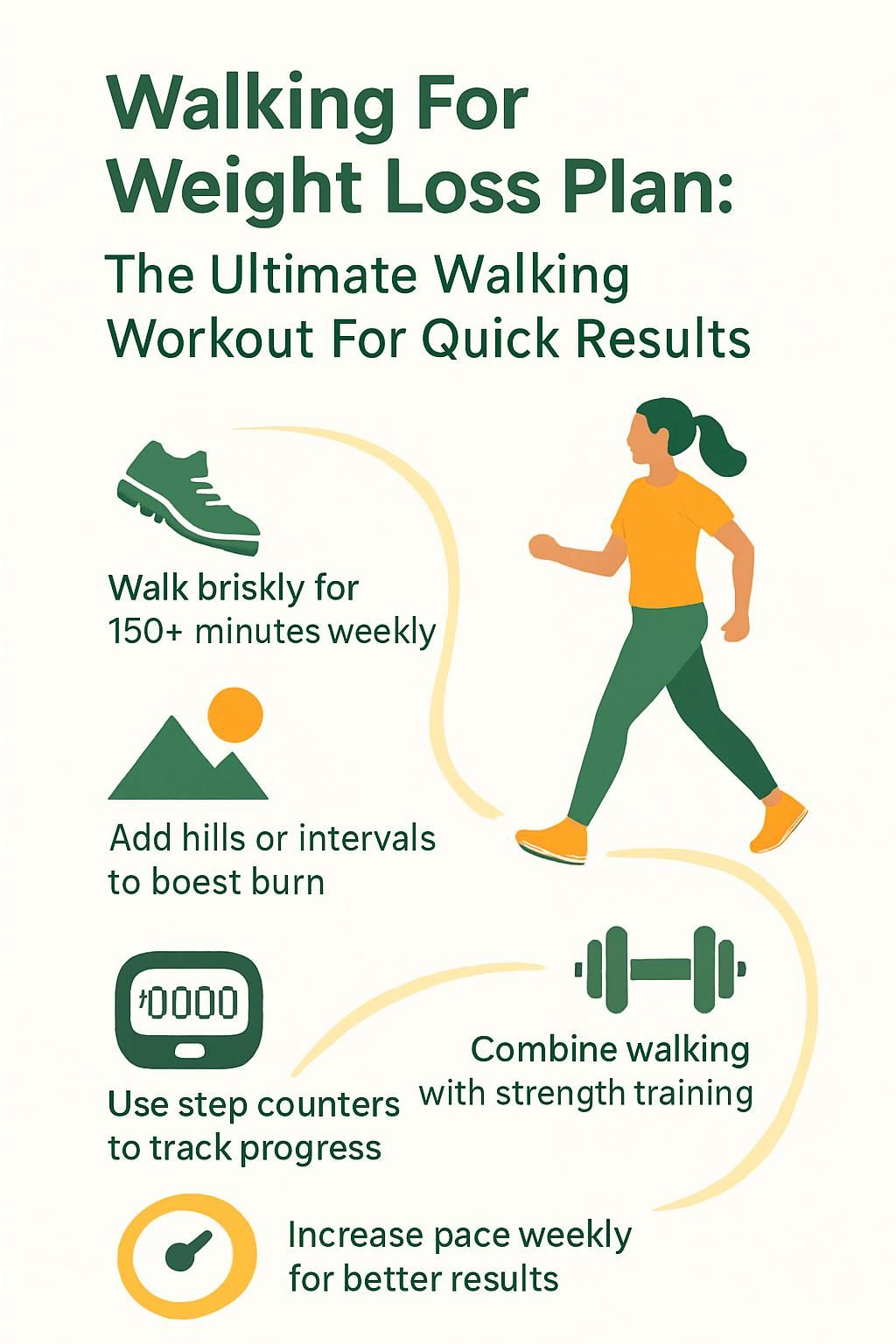Walking For Weight Loss Plan: The Ultimate Walking Workout For Quick Results
Our Nutrition Assistant AI Suite will transform your body. You will lose fat, get toned, and build muscle. Gain confidence and optimal health.
If losing weight feels hard or confusing, you are not alone. Walking for weight loss is simple, safe, and proven to help you burn calories and improve health.
This Walking For Weight Loss Plan gives you clear steps, practical tips, and easy workouts. You will learn how a steady walking routine delivers quick results and better daily energy. Start with the basics, then build week by week.
Keep reading to get started.
Key Takeaways
- Regular brisk walking for at least 150 minutes per week can reduce your risk of heart disease, type 2 diabetes, and high blood pressure by up to 30 percent (CDC).
- Adding hill walks, interval training, arm engagement, and weighted vests can boost calorie burn by 12-60 percent and speed fat loss (ACE, Medicine & Science in Sports & Exercise).
- Using step counters or activity trackers increases daily steps by about 1,800, keeps you motivated, and helps you track calorie burn and pace (peer-reviewed 2022 study).
- Combining walking with strength training, such as squats and lunges, builds muscle, improves stability, and increases total calories burned during weight loss (peer-reviewed studies).
- Following a progressive walking routine with increased duration, pace, and weekly intensity leads to measurable reductions in abdominal fat and improved heart health (Journal of Obesity, 2019).

Why Walking Is an Effective Weight Loss Exercise

Walking is a friendly entry point to a workout for weight loss. It burns calories, improves fitness, and takes little gear or setup.
How Accessible and Low Impact Is Walking?
You can start almost anywhere, like sidewalks, parks, office halls, or a treadmill. Comfortable walking shoes and weather-ready clothing are enough for most people.
No gym fees are required. The Department of Health and Human Services recommends at least 150 minutes per week of moderate aerobic activity, such as a brisk walk.
Walking is gentle on knees and back compared with running. Research shows it lowers injury risk while still supporting heart health, weight management, diabetes prevention, and fitness. This low impact lets you go longer with fewer aches, which makes routine walking easier to maintain for weight loss.
How Does Walking Burn Calories and Boost Metabolism?
Walking uses big muscle groups in your legs and hips. That demand requires energy, so you burn calories. A brisk 30-minute walk can burn about 150-200 calories for someone weighing around 155 pounds, based on American College of Sports Medicine data.
Speed and terrain matter. A faster pace or hilly route raises heart rate and increases energy use. Regular walks improve insulin sensitivity, which helps control blood sugar and supports steady energy.
I began a simple walking plan last year and used a fitness tracker to log progress. With consistent sessions and steady pace, my weekly calorie burn climbed without harsh dieting.
A regular walking program is one of the most accessible ways for anyone to start burning calories daily, says a certified personal trainer featured on AARP’s health channel.
Consistency turns calorie burn into a habit, which supports long-term fitness and health.
How Does Walking Improve Overall Fitness and Health?
Regular walks build endurance and strengthen key muscles in your legs, core, and back. Brisk walking is aerobic exercise, so it supports heart and lung function.
Benefits include healthier blood pressure and improved cholesterol profiles. Daily steps also raise energy and support weight control. Pairing a walking routine with balanced meals helps heart health and supports long-term goals.
What Are the Health Benefits of Walking Regularly?
Walking supports body and mind. It helps you live longer, manage stress, and stay active with fewer barriers.
How Does Walking Boost Heart Health?
Brisk walking raises your heart rate and strengthens the heart muscle. Regular sessions can lower blood pressure and improve cholesterol, two major risk factors for cardiovascular disease.
Research from the American Heart Association shows that 30 minutes a day of moderate walking can reduce the risk of heart attack and stroke by up to 19 percent. Moving at a comfortable pace on most days supports healthy blood flow and may slow plaque buildup.
“You help your heart every time you put on a pair of walking shoes and step outside.” Walking with a friend or family member can make it easier to stay consistent. My blood pressure improved after two months of brisk walks, confirmed at my next checkup.
Can Walking Lower Your Risk of Chronic Diseases?
Regular walking can lower your risk of type 2 diabetes, heart disease, and high blood pressure. Adults who meet activity guidelines with brisk walking for at least 150 minutes per week may reduce these risks by up to 30 percent, according to the CDC.
Walking also helps with diabetes management by improving blood sugar control. Pair your steps with healthy meal plans for greater impact. Using a pedometer helped me develop a steady 30-minute after-dinner walk, which made daily goals easier to hit.
This simple habit can reduce body fat and support kidney function over time.
How Does Walking Improve Mood and Mental Well-being?
Walking supports mental health, not just physical health. Your brain releases endorphins during a brisk walk, and these chemicals reduce stress.
In a 2018 study, short 10 to 15 minute walks lowered anxiety compared with staying still. Many therapists suggest nature walks or listening to a podcast or a favorite playlist while you move.
Sunlight during outdoor walks can lift serotonin in the brain. People who walk consistently often sleep better and focus more. When I began daily walks in Florida, my stress eased within a week.
How Does Walking Increase Energy Levels?
Brisk walking improves blood and oxygen flow to your muscles and brain. As pace increases, endorphins rise and alertness improves.
Walking at least 30 minutes a day can reduce fatigue. People who walk daily report higher energy than those who are inactive. Carry a water bottle and sip during longer or hotter walks. Add short hills or intervals to engage more muscle and increase stamina.
Key Components of an Effective Walking Workout
A strong walking workout uses proper form, smart pacing, and gradual progression. Tracking your data and changing intensity can speed results.
How Do You Maintain Proper Pace and Intensity?
Use the talk test. Aim for a brisk pace that lets you speak in short sentences. If you can sing, go faster. If you are gasping, slow down.
Most adults hit effective calorie burn between 3 and 4 miles per hour. Try an RPE scale, or rating of perceived exertion, from 1 to 10. Keep effort between 5 and 7 for fat loss and fitness.
Track steps, speed, and intensity with a step counter or activity tracker. If you use ankle weights or a light weighted vest, start small to protect joints. Warm up before fast segments, and mix brisk intervals with easier recovery walks.
Why Should You Gradually Extend Walk Duration?
Slow increases protect muscles, joints, and bones. Jumping workout time too quickly can lead to soreness or fatigue.[1] Extending duration raises total calorie burn per session, which supports weight loss.
As your walking plan grows, longer sessions build cardiovascular endurance and stimulate metabolism further.[2] I moved from 15 minutes to 30 minutes over a few weeks. The steady increase made my legs stronger without pain and kept me consistent.
Tracking distance or minutes helps you add time safely and stay motivated.
…
[1] American Heart Association: Physical Activity Recommendations for Adults
[2] Harvard Health Publishing: Walking for health
How Can Interval Training Be Added to Walking?
Alternate short bursts of brisk walking with slower recovery. Warm up for five minutes. Then go fast for one or two minutes, followed by three minutes at an easy pace.
Repeat several times. Try intervals on flat paths, or add a slope for more challenge. Watch how your heart rate responds using a tracker. Intervals strengthen muscles and support weight loss more than steady walking alone.
How Do You Monitor Your Walking Progress?
After you add intervals, track results to measure change. A step counter, smartphone app, or activity tracker can show distance, pace, steps, and calories.
Some walkers log their sessions in a notebook or Google Sheets. Set weekly goals, like total steps or minutes. Reviewing data helps you spot trends and adjust for better results.
What Practical Tips Help You Lose Weight by Walking?
Smart tools and simple habits make your walking plan more effective. Focus on goals, gear, hydration, routes, and tracking.
How Do You Set Achievable Walking Goals?
Start by finding your baseline. Use a tracker to record a typical day of steps. The CDC suggests at least 150 minutes of moderate walking per week for adults.
Create small, clear targets such as 6,000 steps a day for one week, or add 5 minutes to each walk every three days. Adjust as you progress. Track with an app or journal, and celebrate milestones like 10,000 steps or walking to work one day a week.
I began at 5,000 steps a day, then added 500 steps weekly. Progress felt doable, which made the walking for weight loss journey rewarding.
What Are the Best Shoes for Walking Comfort?
Choose walking shoes with cushioning and arch support. The sole should bend at the ball of the foot. A cushioned heel reduces shock and protects joints.
If you have plantar fasciitis, extra heel padding may help. Fit should be snug, not tight. Try shoes late in the day when feet are largest. Wear moisture-wicking socks to prevent blisters. Switching to shoes made for walking improved my comfort and motivation on daily routes.
Hydration is just as important as good footwear.
How Important Is Staying Hydrated While Walking?
Hydration supports temperature control, metabolism, and muscle function. Even mild dehydration can cause fatigue and cramps, which can stall your plan.
Carry a reusable bottle and sip every 15 to 20 minutes during longer walks or heat. Evidence shows that a 2 percent drop in body water can hurt performance. Drinking enough water also supports digestion and nutrient absorption, which helps weight loss and health.
Why Should You Vary Your Walking Routes?
New routes keep workouts interesting and challenge your body in fresh ways. Different surfaces, like sidewalks, grass, or trails, work muscles differently.
Changing paths reduces repetitive strain, which may lower injury risk. I used to loop the same block until a friend suggested nearby parks and hills. That variety made me look forward to walking. Hills can increase calorie burn, with research showing up to 60 percent more calories than flat ground[1].
Fresh air and natural light can also lift mood, especially when activity is consistent.
How Can Step Counters or Activity Trackers Help?
Trackers count steps, show distance, and estimate calories. Set daily goals and see trends over time. A 2022 study showed users increased steps by about 1,800 per day.
Many devices prompt movement after long sitting. I used a step counter while focusing on weight loss and found it pushed me to take extra steps, including a short hill. Most apps let you keep data private while staying focused on progress.
How to Maximize Calorie Burn During Walking
Use proven techniques to burn more calories on every walk. Small changes can produce faster results.
Why Include Hill Walks in Your Routine?
Hills make muscles work harder, which raises energy use. Climbing strengthens legs, glutes, and core more than flat walking.
Steeper slopes elevate heart rate, so metabolism increases. A 2019 study found hill walkers burned about 20 percent more calories than flat walkers. I found that mixing in neighborhood slopes made sessions feel fresh and more challenging.
How Does Wearing Weighted Gear Increase Burn?
Light weighted gear, like a vest or ankle weights, raises the effort needed for each step. Studies from the American Council on Exercise report up to a 12 percent calorie boost with added resistance.
The extra load makes legs and core engage more. Heart rate rises faster, which supports higher energy burn during and after the walk. Use weights carefully and keep them light for safety. Next, learn how purposeful arm motion boosts results.
How Can You Actively Engage Your Arms While Walking?
Bend your elbows about 90 degrees and swing from the shoulders. Keep hands relaxed to avoid tension. A strong arm swing can raise calorie burn by up to 15 percent in studies.
Maintain tall posture with shoulders back. If you add light hand weights, start with one pound each. During my spring training for a local fun walk, stronger arm drive made hills feel easier and pace steadier.
What Are Speed Bursts and How to Use Them?
Speed bursts are short segments at a much faster pace. Pick a landmark like a mailbox and power walk to it.
Start with several 30 second bursts. Recover at a normal pace for one to two minutes. Research shows this interval style burns more carbohydrates and fat while improving cardiovascular fitness. Use a tracker to time bursts and record progress.
Weekly Walking Plan for Weight Loss: Step-by-Step
A weekly structure builds habits and keeps you moving forward. Use the plan below as a guide and adjust if needed.
What Does Week 1: Routine Foundation Look Like?
Set a schedule of five sessions at 20 to 30 minutes each, at a comfortable pace. Focus on consistency to prepare for later intensity. Choose flat, even routes to reduce joint stress.
Wear supportive shoes and track steps with a counter or activity tracker. Hydrate before and after walks. A light snack with whole grain carbohydrates helps steady energy. These basics help muscles adapt and set up long-term success.
How to Introduce Brisk Pacing in Week 2?
Shift to brisk walking where you can talk but not sing, roughly 3.5 to 4 miles per hour for many adults. With a tracker, aim for about 100 steps per minute for at least 10 minutes at a time.
Add one or two brisk sessions on non-consecutive days. Adjust privacy settings in any app you use. This increase raises calorie burn without high impact compared with running or jump-heavy training like squat sets¹²³⁴⁵.
How to Add Intervals and Slopes in Weeks 3-4?
Begin week 3 with short intervals. Walk three minutes at normal pace, then one minute brisk. Repeat for five to eight rounds per session. Interval walking can raise calorie burn and improve heart health[1].
In week 4, add gentle slopes or hills if available. Uphill walking can burn up to 30 percent more calories than flat routes[2]. I added small hills twice weekly and saw quicker changes on the scale. Keep tracking progress as you layer these changes.
…
[1] Journal of Obesity: “Interval Training Versus Continuous Moderate Exercise” (2019)
[2] Medicine & Science in Sports & Exercise: “Energy Cost of Inclined Treadmill Walking” (2020)
How to Extend Duration and Distance Weeks 5-8?
Now increase time and distance. Add 5 to 10 minutes each week. If you walked 30 minutes most days, move to 35-40 minutes in week 5. Keep adding small increments weekly.
Track weekly distance or total steps with your device. My stamina improved after reaching about 8,000-10,000 steps daily by week 8. Include one longer weekend walk, about 60 minutes at a moderate pace. Mixing brisk short walks with one longer steady session supports heart health and calorie burn.
What Advanced Calorie Burn Techniques Are Used Weeks 9-12?
Use power intervals, one minute fast and two minutes moderate. Studies show intervals raise metabolism and fat burning compared with steady pace. Add steeper hills or stair segments for extra challenge. Both can sharply increase energy use.
Consider a light weighted vest or ankle weights, kept under 10 percent of body weight for safety. Swing arms with purpose and lengthen strides during brisk segments. Aim for at least 10,000 steps daily, tracked with a counter or app. These methods help shed fat while protecting muscle.
How Does Walking Target Abdominal Fat?
Consistent walking reduces belly fat through steady calorie burn and improved metabolism. Pair it with smart food choices for best results.
How Does Walking Help Reduce Belly Fat?
Walking creates a calorie deficit, which reduces body fat, including abdominal fat. Research shows 30 to 60 minutes of moderate walking five days a week can lower waist measurements.
Brisk pace increases heart rate and energy use from fat stores. A tracker helps you stay consistent, which improves outcomes. Walking can also lower cortisol, a stress hormone linked with belly fat. Aim for at least 150 minutes weekly for steady change.
Why Combine Walking with Nutritious Eating?
Balanced meals help you walk longer and recover better. Eating fiber, lean protein, and healthy fats provides steady fuel. Reducing added sugars and highly processed foods makes calorie control easier.
Small swaps add up. Choose water instead of sugary drinks. Pick whole grains instead of white bread. These changes support the results you earn from your walking workout.
Why Combine Strength Training with Walking?
Strength work builds muscle, which burns more calories even at rest. Combining both approaches produces better weight loss results than walking alone in many studies.
What Are the Benefits of Mixed Exercise Routines?
Mixing walking and strength training increases calorie burn and protects lean muscle. It also reduces overuse by changing which muscles work hardest on a given day.
Varied training keeps your mind engaged. It challenges the body in new ways, which supports a stronger metabolism and better heart health. Many coaches suggest blended routines for long-term progress.
Which Strength Exercises Complement Walking Best?
Use bodyweight moves like squats, lunges, and push-ups to build strength and stability. Add bands for rows and curls to train the upper body without heavy equipment. Planks and glute bridges improve core and hip strength, which makes your stride more efficient.
Complete two or three strength sessions weekly. Start with one set of 8 to 12 repetitions for each move. Build to two or three sets as you get stronger. This combination supports joints and lowers injury risk.
What Common Mistakes Should You Avoid in Walking Workouts?
A few missteps can slow results. Avoid these pitfalls to keep your plan effective and safe.
Why Should You Avoid Overestimating Calories Burned?
Many trackers and calculators inflate calorie numbers. Eating extra to match those estimates can stall weight loss.
A brisk mile can burn about 100 to 150 calories, depending on pace, weight, and terrain. Stanford research found some devices overestimated by up to 27 percent. A fast walk marked as 300 calories could be closer to 220. Use conservative numbers and track food carefully to match real activity.
Good estimates help you create a true calorie deficit. Next, refine your technique for better efficiency.
How Important Is Proper Walking Form?
Form matters for comfort and performance. Stand tall, relax your shoulders, and look ahead, not down. Bend elbows near 90 degrees and swing from the shoulders to add speed and balance.
Good posture reduces strain on back, knees, and hips, and helps you breathe more easily. Efficient form turns everyday steps into a reliable weight loss exercise.
Why Are Rest Days Necessary?
Rest days allow muscles to repair after brisk or interval walks. They help prevent shin splints, joint pain, and fatigue.
Short breaks restore energy and keep motivation high. I once walked daily and felt heavy by week’s end. Adding one or two rest days improved recovery and made each session more enjoyable.
Conclusion
Walking for weight loss is a practical path to better health. Each step can lift energy, tone muscles, and burn calories. With this walking workout for weight loss, you build momentum week after week.
Pick supportive shoes, set clear goals, and track your steps for motivation. Pair your walking plan with balanced meals and simple strength work for faster progress. With steady effort, you can trim belly fat and protect your heart.
Walking fits busy schedules and all fitness levels. Start today, be consistent, and let your results build. For medical conditions or pain, consult a healthcare professional before changing your exercise routine.
FAQs
1. How effective is a walking workout for weight loss compared to other exercise plans?
Walking can help burn calories and support weight loss, especially when paired with a healthy diet. Studies from the Centers for Disease Control and Prevention show that brisk walking for 30 minutes can burn about 150 calories in an average adult. Walking is low-impact, making it suitable for most people who want to lose weight without high injury risk.
2. What is the best walking plan to achieve quick results in weight loss?
A structured walking plan includes brisk walks five days per week, with each session lasting at least 30 minutes. Increasing pace or adding intervals of faster walking can boost calorie burn. According to research published in Obesity Reviews, interval walking may lead to greater fat loss than steady-paced walking.
3. How many calories can I expect to burn with a daily walking workout?
The number of calories burned depends on your body weight, walking speed, and duration. For example, a person weighing 160 pounds burns about 314 calories per hour at a pace of four miles per hour. A table of calorie expenditure by pace and body weight can help you estimate your own results.
4. Can personal experience support the benefits of a walking plan for weight loss?
Many individuals report steady progress with a consistent walking routine. For instance, after following a daily brisk walking plan and tracking both steps and food intake, I lost ten pounds in three months while maintaining energy levels and muscle tone.
Summary:
Walking offers a practical and evidence-based approach to weight loss. A regular walking plan with increased intensity or intervals can enhance results. Calorie burn varies by pace and body weight but remains significant with consistency. Personal stories confirm that walking supports both weight loss and overall well-being.







